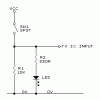Thanks to the great help on my first post, I've been working through a few more IC's and have now dived in to something a bit more complicated: the 74HC138N inverting demultiplexer http://www.nxp.com/documents/data_sheet/74HC_HCT138.pdf
Behavior is working perfectly as expected: numbering LED's from 0 to 7, input binary 0 turns off LED 0, binary 7 turns off LED 7 etc (and all other LED's remain on, because this is the "inverting" version of the chip)
Two questions:
1) How do the three "enable" pins work? I can't make sense of the datasheet and can't find much info online. People mention the word "strobe" and linking up multiple chips... but pieces not really fitting together. According to my eyes, (my multimeter is all the way down in my car!) unless both E1 and E2 are low, and E3 is high, then ALL outputs = High.
2) Short of using transistors, could I have wired up my input pins any bit better? I've got three LED's linked to my Input = High: although previous post taught me about pull-up resistors (and i'm using them on enable lines) I couldn't think of how to apply the same theory if I wanted to also drive LED's in parallel with my input lines (short of using Transistors, of which I have none while waiting for Ebay shipment
I've got three LED's linked to my Input = High: although previous post taught me about pull-up resistors (and i'm using them on enable lines) I couldn't think of how to apply the same theory if I wanted to also drive LED's in parallel with my input lines (short of using Transistors, of which I have none while waiting for Ebay shipment  I don't have an actual "switch" per say, just hook-up cables I'm switching between +5V and GND... so input = floating in the second or so in between which I know is bad but perhaps not a huge deal for my basic "learning" application here...
I don't have an actual "switch" per say, just hook-up cables I'm switching between +5V and GND... so input = floating in the second or so in between which I know is bad but perhaps not a huge deal for my basic "learning" application here...
Thanks for any insights

Behavior is working perfectly as expected: numbering LED's from 0 to 7, input binary 0 turns off LED 0, binary 7 turns off LED 7 etc (and all other LED's remain on, because this is the "inverting" version of the chip)
Two questions:
1) How do the three "enable" pins work? I can't make sense of the datasheet and can't find much info online. People mention the word "strobe" and linking up multiple chips... but pieces not really fitting together. According to my eyes, (my multimeter is all the way down in my car!) unless both E1 and E2 are low, and E3 is high, then ALL outputs = High.
2) Short of using transistors, could I have wired up my input pins any bit better?
Thanks for any insights


